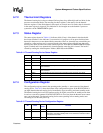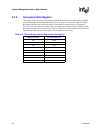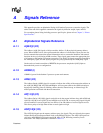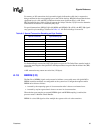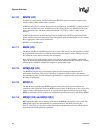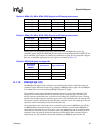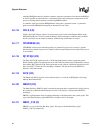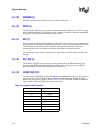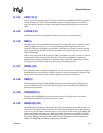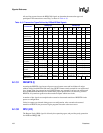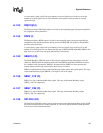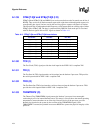
Datasheet 97
Signals Reference
A.1.22 DBSY_C2# (O)
DBSY# is a copy of the Data Bus Busy signal. This copy of the Data Bus Busy signal
(DBSY_C2#) is an output only.
A.1.23 DEFER# (I)
The DEFER# signal is asserted by an agent to indicate that the transaction cannot be guaranteed in-
order completion. Assertion of DEFER# is normally the responsibility of the priority agent.
A.1.24 DEN# (I/O)
The Defer Enable (DEN#) signal is driven on the bus on the second clock of the Request Phase on
the Ab[4]# pin. DEN# is asserted to indicate that the transaction can be deferred by the responding
agent.
A.1.25 DEP[15:0]# (I/O)
The Data Bus ECC Protection (DEP[15:0]#) signals provide optional ECC protection for Data Bus
(D[127:0]#). They are driven by the agent responsible for driving D[127:0]#. During power-on
configuration, bus agents can be enabled for either ECC checking or no checking.
The ECC error correcting code can detect and correct single-bit errors and detect double-bit or
nibble errors.
A.1.26 DHIT# (I)
The Deferred Hit (DHIT#) signal is driven during the Deferred Phase by the deferring agent. For
read transactions on the bus DHIT# returns the final cache status that would have been indicated on
HIT# for a transaction which was not deferred. DID[9:0]# (I/O)
DID[9:0]# are Deferred Identifier signals. The requesting agent transfers these signals by using
A[25:16]#. They are transferred on Ab[25:16]# during the second clock of the Request Phase on all
transactions, but Ab[20:16]# is only defined for deferrable transactions (DEN# asserted).
DID[9:0]# is also transferred on Aa[25:16]# during the first clock of the Request Phase for
Deferred Reply transactions.
The Deferred Identifier defines the token supplied by the requesting agent. DID[9]# and DID[8:5]#
carry the agent identifiers of the requesting agents (always valid) and DID[4:0]# carry a transaction
identifier associated with the request (valid only with DEN# asserted). This configuration limits the
bus specification to 32 logical bus agents with each one of the bus agents capable of making up to
32 requests. Table A-7 shows the DID encodings.
DID[9]# indicates the agent type. Symmetric agents use 0. Priority agents use 1. DID[8:5]#
indicates the agent ID. Symmetric agents use their arbitration ID. DID[4:0]# indicates the
transaction ID for an agent. The transaction ID must be unique for all deferrable transactions issued
by an agent which have not reported their snoop results.
Table A-7. DID[9:0]# Encoding
DID[9]# DID[8:5]# DID[4:0]#
Agent Type Agent ID[3:0] Transaction ID[4:0]



